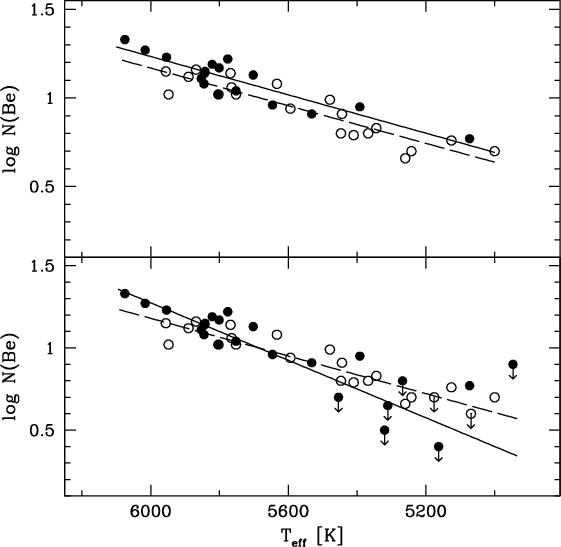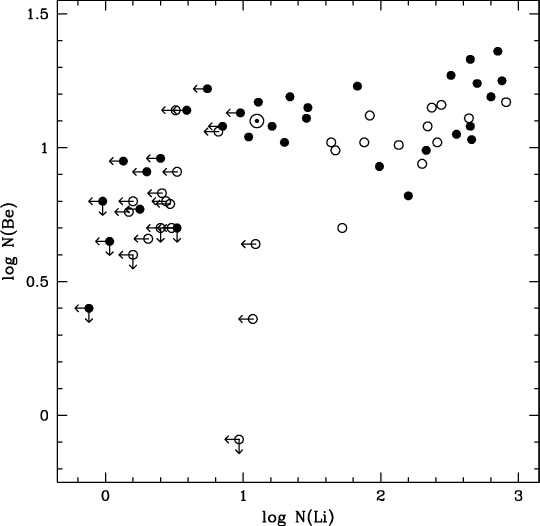Censoring: Planet host stars
The CASt dataset
censor.datAstronomical background
The following is a common situation in observational astronomy. A previously identified sample of objects (stars, galaxies, quasars, X-ray sources, etc.) are observed at some new wavelength or for some new property. Some of the target objects are detected and the value of the new property is measured (with a known measurement error), while others are not detected. These are assigned an upper limit to the value of the property based on the uncertainty of the unsuccessful measurement. The result is new column in a multivariate database where the rows represent the objects and the columns represent values of various properties. The new column has measured values with errors, and upper limits. Statisticians call these "left-censored" data points. Many astronomical studies encounter such problems, particularly in extragalactic astronomy.
A large suite of statistical methods have been developed to treat right-censored datasets because these frequently arise in "survival" studies; that is, examination of how long a population "lives" under various situations when the experiment is stopped before all members of the population have "died". This situation arises in actuarial (where the objects are ordinary people), industrial reliability (where the objects are often manufactured products), and biomedical studies (where the objects are usually ill people or test animal samples). During the 1980-90s, survival analysis methods were adapted for use in astronomical surveys with nondetections. The ASURV code, used in several hundred astronomical studies to date, implements a number of survival methods: the Kaplan-Meier univariate maximum likelihood estimator; Gehan and other two-sample tests; generalized rank correlation coefficients for bivariate problems; and bivariate linear regressions.
Astronomical censoring problems often differ from those encountered in ordinary survival applications is various ways: censoring is not restricted to a single dependent variable but can occur anywhere in the multivariate dataset; a point can be simultaneously censored in several properties; distance-dependent censoring produce non-random censoring patterns; detected points have heteroscedastic measurement errors; the censored values are imprecise because they are based on the measurement errors. Despite these problems, survival methods are often used because they overcome much of the bias due to nondetections.
Dataset
Here we present a censored dataset from stellar astronomy where the authors seek differences in the properties of stars that do and do not host extrasolar planetary systems. It had already been established that the probability of finding a planet is a steeply rising function of the star's metal content, but it was unclear whether this arises from the metallicity at birth or from later accretion of planetary bodies. This study focuses on the abundances of the light elements beryllium (Be) and lithium (Li) that are thought to be depleted by internal stellar burning, so that excess Be and Li should be present only in the planet accretion scenario of metal enrichment.
The dataset and figures below are obtained from the following paper:
- Are beryllium abundances anomalous in stars with
giant planets? N. C. Santos, G. Israelian, R. J. García
López, M. Mayor, R. Rebolo, S. Randich, A. Ecuvillon, and C. Domínguez
Cerdeña; Astronomy & Astrophysics, 437, 1086-1096 (2004)
The columns of the dataset are:
- Star name
- Sample. Type=1 indicates planet-hosting stars. Type=2 is the control sample
- Teff (in degrees Kelvin) stellar surface temperature
- log N(Be), log of the abundance of beryllium scaled to the Sun's abundance (i.e. the Sun has log N(Be)=0.0).
- Measurement error to log N(Be) based on model-fitting of the observed stellar spectrum
- log N(Li), log of the abundance of lithium scaled to the
Sun's abundance
The dataset consists of 39 stars known to host planets (plotted as filled circles) and 29 stars in a control sample (open circles). Due to internal stellar processes, Be abundances are correlated with stellar mass which is traced by stellar surface temperature ("effective temperature" or Teff). Regression lines of the detections only (top panel) show a slight elevation in Be abundance for planet hosting stars, but this difference evaporates when a Buckley-James regression line is considered that includes the effects of censoring (bottom panel).

The scatter plot below shows that Be and Li abundances are interdependent in a complicated fashion, but little difference is seen between the planet-hosting and control samples.

Statistical exercises
- Use standard univariate survival analysis methods to onstruct Kaplan-Meier distributions of Be and Li abundances for the planet-hosting and control samples. Find means and medians, and apply two-sample tests for differences.
- Perform the same but with heteroscedastic weighting for the Be abundances.
- Apply bivariate correlation tests and linear regressions to the Be-vs-Li plots shown above. Note that ASURV implements the Brown, Hollander & Korwar generalized Kendall's tau that permits censoring in both variables.
- Extend bivariate survival methods to the multivariate case. See the Akritas & Siebert trivariate partial correlation coefficient for multiply censored data based on Kendall's tau.